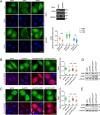Phosphorylation of Arl4A/D promotes their binding by the HYPK chaperone for their stable recruitment to the plasma membrane
- PMID: 35857868
- PMCID: PMC9335210
- DOI: 10.1073/pnas.2207414119
Phosphorylation of Arl4A/D promotes their binding by the HYPK chaperone for their stable recruitment to the plasma membrane
Abstract
The Arl4 small GTPases participate in a variety of cellular events, including cytoskeleton remodeling, vesicle trafficking, cell migration, and neuronal development. Whereas small GTPases are typically regulated by their GTPase cycle, Arl4 proteins have been found to act independent of this canonical regulatory mechanism. Here, we show that Arl4A and Arl4D (Arl4A/D) are unstable due to proteasomal degradation, but stimulation of cells by fibronectin (FN) inhibits this degradation to promote Arl4A/D stability. Proteomic analysis reveals that FN stimulation induces phosphorylation at S143 of Arl4A and at S144 of Arl4D. We identify Pak1 as the responsible kinase for these phosphorylations. Moreover, these phosphorylations promote the chaperone protein HYPK to bind Arl4A/D, which stabilizes their recruitment to the plasma membrane to promote cell migration. These findings not only advance a major mechanistic understanding of how Arl4 proteins act in cell migration but also achieve a fundamental understanding of how these small GTPases are modulated by revealing that protein stability, rather than the GTPase cycle, acts as a key regulatory mechanism.
Keywords: Arf-like GTPase; HYPK; Pak1; cell migration; protein stability.
Conflict of interest statement
The authors declare no competing interest.
Figures








Similar articles
-
Cooperative recruitment of Arl4A and Pak1 to the plasma membrane contributes to sustained Pak1 activation for cell migration.J Cell Sci. 2020 Feb 4;133(3):jcs233361. doi: 10.1242/jcs.233361. J Cell Sci. 2020. PMID: 31932503
-
The Arf family GTPase Arl4A complexes with ELMO proteins to promote actin cytoskeleton remodeling and reveals a versatile Ras-binding domain in the ELMO proteins family.J Biol Chem. 2011 Nov 11;286(45):38969-79. doi: 10.1074/jbc.M111.274191. Epub 2011 Sep 19. J Biol Chem. 2011. PMID: 21930703 Free PMC article.
-
ADP-ribosylation factor-like 4A interacts with Robo1 to promote cell migration by regulating Cdc42 activation.Mol Biol Cell. 2019 Jan 1;30(1):69-81. doi: 10.1091/mbc.E18-01-0001. Epub 2018 Nov 14. Mol Biol Cell. 2019. PMID: 30427759 Free PMC article.
-
Allosteric regulation of Arf GTPases and their GEFs at the membrane interface.Small GTPases. 2016 Oct;7(4):283-296. doi: 10.1080/21541248.2016.1215778. Epub 2016 Jul 22. Small GTPases. 2016. PMID: 27449855 Free PMC article. Review.
-
Arf proteins in cancer cell migration.Small GTPases. 2016 Oct;7(4):270-282. doi: 10.1080/21541248.2016.1228792. Epub 2016 Sep 2. Small GTPases. 2016. PMID: 27589148 Free PMC article. Review.
Cited by
-
The phosphorylation of Pak1 by Erk1/2 to drive cell migration requires Arl4D acting as a scaffolding protein.J Cell Sci. 2025 May 15;138(10):jcs263812. doi: 10.1242/jcs.263812. Epub 2025 May 22. J Cell Sci. 2025. PMID: 40309925 Free PMC article.
-
A combination of transcriptomics and epigenomics identifies genes and regulatory elements involved in embryonic tail development in the mouse.BMC Biol. 2025 Mar 26;23(1):88. doi: 10.1186/s12915-025-02192-0. BMC Biol. 2025. PMID: 40140914 Free PMC article.
-
The underlying molecular mechanisms and biomarkers of Hip fracture combined with deep vein thrombosis based on self sequencing bioinformatics analysis.J Orthop Surg Res. 2025 May 16;20(1):474. doi: 10.1186/s13018-025-05668-5. J Orthop Surg Res. 2025. PMID: 40380263 Free PMC article.
-
BAG6 supports stress fiber formation by preventing the ubiquitin-mediated degradation of RhoA.Mol Biol Cell. 2023 Apr 1;34(4):ar34. doi: 10.1091/mbc.E22-08-0355. Epub 2023 Mar 8. Mol Biol Cell. 2023. PMID: 36884293 Free PMC article.
-
Glycerol mediates crosstalk between metabolism and trafficking through the golgin Imh1.Nat Struct Mol Biol. 2025 Jul 8. doi: 10.1038/s41594-025-01600-x. Online ahead of print. Nat Struct Mol Biol. 2025. PMID: 40629165
References
-
- Chen K. J., Chiang T. C., Yu C. J., Lee F. S., Cooperative recruitment of Arl4A and Pak1 to the plasma membrane contributes to sustained Pak1 activation for cell migration. J. Cell Sci. 133, jcs233361 (2020). - PubMed
-
- Chen Q., et al. , ARL4C stabilized by AKT/mTOR pathway promotes the invasion of PTEN-deficient primary human glioblastoma. J. Pathol. 247, 266–278 (2019). - PubMed
Publication types
MeSH terms
Substances
LinkOut - more resources
Full Text Sources
Molecular Biology Databases
Research Materials
Miscellaneous

